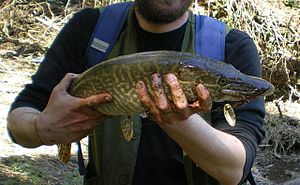Esox cisalpinus
| Esox cisalpinus | ||||||||||||
|---|---|---|---|---|---|---|---|---|---|---|---|---|

Esox cisalpinus |
||||||||||||
| Systematics | ||||||||||||
|
||||||||||||
| Scientific name | ||||||||||||
| Esox cisalpinus | ||||||||||||
| Bianco & Delmastro , 2011 |
Esox cisalpinus ( Syn . : Esox flaviae Lucentini et al., 2011) is a species of pike ( Esox )newly described in 2011. It includes the pike populations of northern and central Italy, which were thus separated from the northern European pike ( Esox lucius ) and were given their own species status. The species was first described by Bianco & Delmastro in an inventory of endemic fish species of the Italian peninsula as Esox Cisalpinus described and a short time later by Lucentini et al. as Esox flaviae . According to the priority rule of biological nomenclature , the first name, Esox cisalpinus , is valid.
distribution
Esox cisalpinus occurs in northern Italy south of the Alps and in central Italy. Whether other pike populations in the Mediterranean area, e.g. B. in southern France and in the tributaries of the Adriatic must also be added to the new species, has not yet been clarified.
features
Esox cisalpinus is a maximum of one meter long, is elongated and has a flattened, duck-like snout. The big mouth is covered with many pointed teeth. The dorsal and anal fins are located far back near the caudal fin, while the pectoral and ventral fin are low on the body. In addition to metric characteristics, the proportions between different body masses, Esox cisalpinus mainly differs in color and the smaller number of scales along the lateral line from Esox lucius .
Esox cisalpinus is very variable in color and can have longitudinal stripes, transverse stripes, diagonal stripes or a star-shaped branching stripe. However , he never shows the round spots typical of Esox lucius .
- Fins formula : dorsal i – ii / 13–16, anal i – ii / 11–13, caudal 14–18.
- Scale formula : SL 101–115, (125–148 in E. lucius )
- Branchiostegal rays : 13-14.
Way of life
Like the northern European pike, Esox cisalpinus occurs mainly in clear, vegetation-rich lakes and rivers. It is solitary, territorial and feeds on fish, also smaller conspecifics, frogs and crabs. Males first reproduce at one year of age, females at two years of age. Reproduction takes place in central Italy from February to March, in northern Italy from March to April.
literature
- Bianco, PG & Delmastro, GB (2011): Recenti novità tassonomiche riguardanti i pesci d'acqua dolce autoctoni in Italia e descrizione di una nuova specie di luccio. Researches on Wildlife Conservation (IGF publ.), 2 (suppl.): 1-13. PDF
- Lucentini, L., Puletti, ME, Ricciolini, C., Gigliarelli, L., Fontaneto, D., Lanfaloni, L., Bilò, F., Natali, M. & Panara, F. (2011): Molecular and Phenotypic Evidence of a New Species of Genus Esox (Esocidae, Esociformes, Actinopterygii): The Southern Pike, Esox flaviae. PLoS ONE, 6 (12): 1-14. doi : 10.1371 / journal.pone.0025218
Web links
- Esox cisalpinus on Fishbase.org (English)